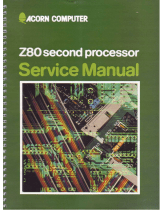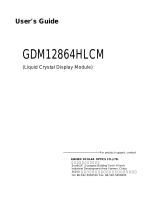
RTC - 72421 / 72423
Page - 9 MQ - 162 - 03
Register description
1. Timing registers
(1) S1 to Y10 registers
These registers are 4-bit, positive logic registers in which the digits of the year, month, day, hour, minute, and second are
continuously written in BCD code.
For example, when(1, 0, 0, 1) has been written to the bits of the S1 register, the current value in the S1 register is 9. As
described previously, data is handled by 4-bit BCD codes. Therefore, the S1 to Y10 registers consist of units registers and
tens registers.
When seconds are read, for example, the values in the S1 and S10 registers are both read out to give the total number of
seconds.
(2) W register
The W register is a counter that increments each time the day digits are incremented. It counts from 0 to 6. Since the value in
the counter bears no relationship to the day of the week, the user can choose the coding that relates the counter value to the
day of the week. The following is just one example of this relationship;
Count 0 1 2 3 4 5 6
Day Sunday Monday Tuesday Wednesday Thursday Friday Saturday
(3) H10 register (PM/AM, h20, h10)
The H10 register contains a combination of the 10-hours digit bits and the PM/AM bit. Therefore, the contents of this register
will depend on whether the 12-hour clock or 24-hour clock is selected. If the 12-hour clock is selected, the user must bear in
mind that this register will contain two types of data: 10-hour data in the h10 bit and a.m./p.m. data in the PM/AM bit. The
PM/AM bit is 0 for a.m. and 1 for p.m.
For example, if a value of 48 is obtained from the H10 and H1 registers when the H10, H1, M10, and M1 registers are read,
remember that the inclusion of a set PM/AM bit (PM/AM=1) will make the tens digit appear to be 4. Since this bit is 1, the time
is p.m. If the value read from the M10 and M1 registers is 00, the actual time should be read as 8:00 p.m.
Similarly, if the value read from the H10 and H1 registers is 11, the PM/AM bit is 0, and so this time is therefore a.m. If the
value read from the M10 and M1 registers is 30, this time should be read as 11:30 a.m.
When the 12-hour clock is used, the h20 bit should never be 1, but it is nonetheless physically possible to write a 1 in this bit.
The user should be careful to write a 0, to avoid unpredictable consequences. Note that, if a mistake in the PM/AM value is
made while in 12-hour-clock mode, the date digits will be half a day out. Correct setting is needed.
If the 24-hour clock is selected, the PM/AM bit will always be 0.
For details of how to set 12-hour or 24-hour clock, see the section on the 24/12 bit.
Setting Possible times
12-hour clock 12:00 to 11:59, a.m. and p.m.
24-hour clock 00:00 to 23:59
(4) Y1 and Y10 registers
The Y1 and Y10 registers can handle the last two digits of the year in the Gregorian calendar.
Leap years are automatically identified, and this affects the handling of the month and day digits
for February 29.
[ Leap years ]
In general, a year contains 365 days. However, the Earth takes slightly longer than exactly 365
days to rotate around the sun, so we need to set leap years in compensation. A leap year occurs
once every four years, in years in the Gregorian calendar that are divisible by four. However, a
further small correction is necessary in that years that are divisible by 100 are ordinary years, but
years that are further divisible by 400 are leap years.
The main leap and ordinary years since 1900 and into the future are listed on the right.
[ Leap years in the RTC-72421/72423 ]
To identify leap years, the RTC-72421/RTC-72423 checks whether or not the year digits are
divisible by four. As implied above, 2000 will be a leap year, and so no further correction will be
necessary in that case.
This process identifies the following years as leap years:
96, (20)00, (20)04, (20)08, (20)12...
The turn-of-the-century years for which the RTC-72421/RTC-72423 will require a correction are
shown shaded in the table on the right.
If Japanese-era years are set, accurate leap-year identification will only be possible if the era
years that are divisible by four are actually leap years. As it happens, years in the current era,
Heisei, that are divisible by four are leap years, which means that Heisei years can be set in these
registers.
(5) Out-of-range data
If an impossible date or time is set, this may cause errors. If such a date is set, the behavior of the device is in general
unpredictable, so make sure that impossible data is not set.
Actual leap years and ordinary years
Year Leap year Ordinary
year
1900
Ο
:
1993
Ο
1994
Ο
1995
Ο
1996
Ο
1997
Ο
1998
Ο
1999
Ο
2000
Ο
2001
Ο
2002
Ο
2003
Ο
2004
Ο
2005
Ο
:
2100
Ο
2200
Ο
2300
Ο
2400
Ο





















